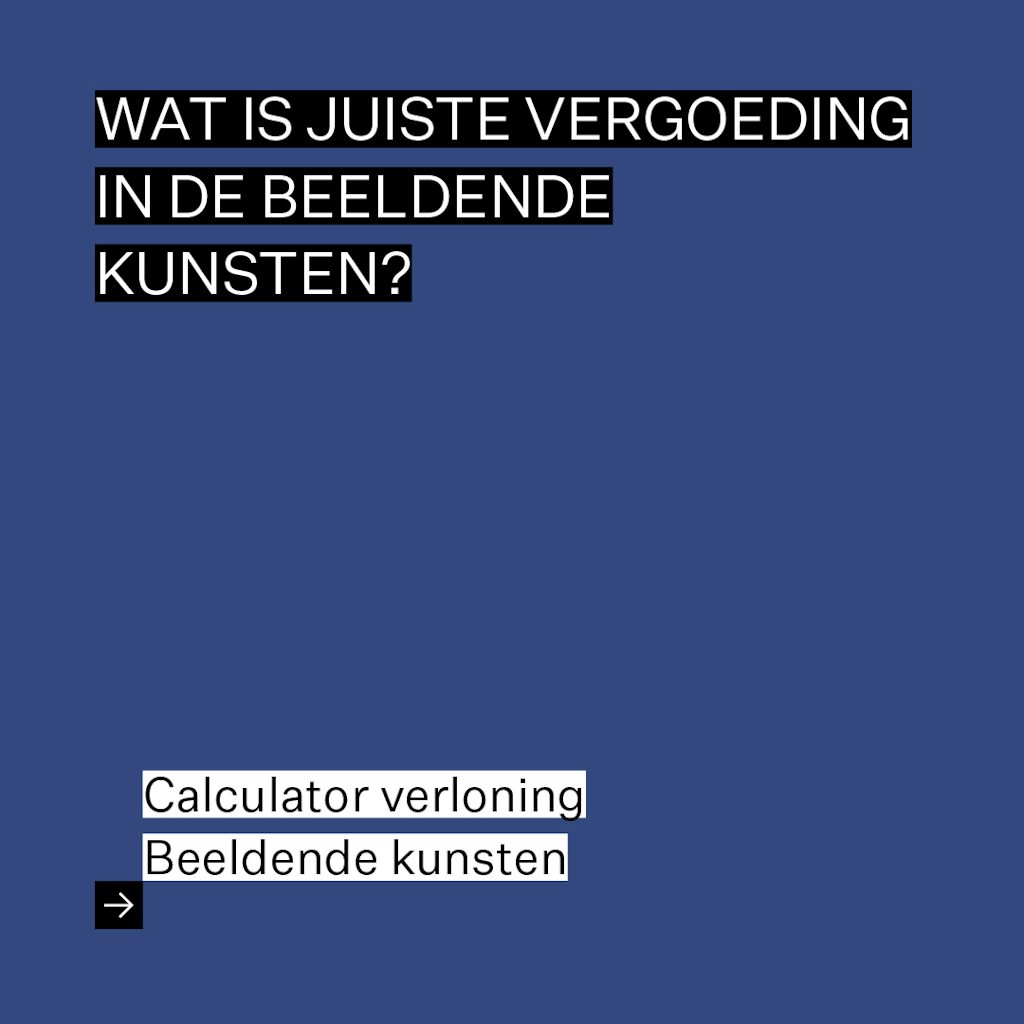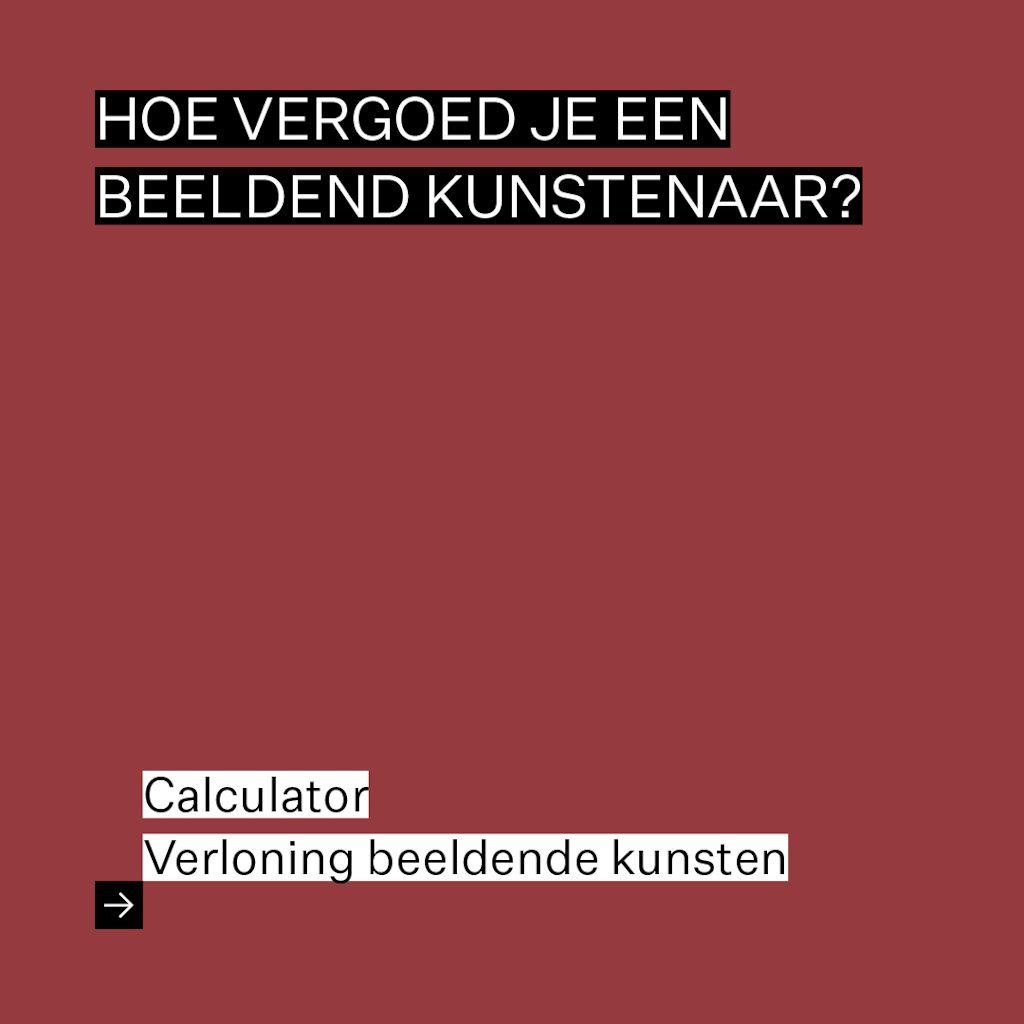How should you remunerate a visual artist?

New guideline and online tool for remunerating artists and curators
“You do it out of passion and not for the money”, “you should be happy that we’re letting you exhibit … after all it’s an honour, or it will increase your market value”. These are just a few of the statements that visual artists often hear. Today, two thirds of all Flemish visual artists receive no compensation for their work. We want to put an end to these situations and start converting the appreciation of artistic achievements into a fair wage.
70% receive no compensation
Visual artists have the lowest income on average of all artists.* Only 30% of artists indicate that they are compensated for creating their work or for exhibiting it. Research and prospecting, often very time-intensive work, are also usually not reimbursed. To make ends meet, artists combine their artistic practice with a paid job outside the sector. The situation is more or less the same for freelance curators. Despite the increased attention for fair practice and fair pay in the arts sector, there is still a deep-rooted tradition of remunerating artists and curators with symbolic capital such as prestige or networking opportunities.
Strong differences in compensation between organisations
Research by Eva Vanacker shows that only some organisations allocate a separate remuneration amount in the production budget. If an organisation foresees a wage, this usually concerns fixed amounts per project or exhibition that are not proportional to the amount of work involved. Moreover, practices regarding compensation differ greatly among organisations.
The Flanders Arts Institute study “Loont Passie” [Does Passion Pay?] confirms that visual artists earn the least of all artists. In 2020, Flanders Arts Institute brought together representatives of artists, arts organisations and curators to create a guideline for remuneration in the visual arts that (structurally) subsidised organisations will use when submitting applications for an operating subsidy in December 2021, and for the next round of project subsidy applications in May 2022.
Dirk De Wit, Flanders Arts Institute
New guideline for a fair wage: How should you calculate it?
In the fall of 2020, a working group was started to draw up a framework for the correct remuneration of visual artists and freelance curators. In this, the working group took into account the principles of ‘Juist is Juist’ [What’s Right is Right], an online toolbox with clear and fair practices for collaborations in the arts sector.
Correct remuneration is calculated on the basis of the following principles:
- Time as a parameter for correct compensation, linked to the applicable wage scales
- A feasible project budget in which the agreed wage is distinguished from other budget items
- Arrangements about the use of existing work in the form of a presentation fee
- Other financial arrangements about transport, insurance, purchase and sale
- All arrangements are established in writing
And a new online calculation tool
To help artists, curators and organisations put the guideline into practice, a compensation calculator was also developed. This allows you to calculate correct compensation for artists and curators, in the form of paid employment as well as in the form of compensation for the self-employed.
The new guideline and the calculator are available on the Juist is Juist website.
*Study Loont Passie (Flanders Arts Institute 2016)

Juist is juist?
Juist is Juist [What’s Right is Right] is a platform and a toolbox. It defines clear and fair principles and practices for collaborating in the arts sector. Juist is Juist was created in a long process with many partners, under the coordination of oKo, the advocacy, employers’ federation and network organisation of professional arts organisations in Flanders and Brussels.
Policy vision of the Minister
The guidelines and the calculator are in line with the policy vision of Minister Jambon. In his vision statement, Minister Jambon indicated that he wants to strengthen the position of the visual arts sector and of individual artists especially by, among others, developing a calculator for fair remuneration.
In addition, the principles of fair practices have been included in the Arts Decree. These involve solidarity, sustainability, transparency and responsibility. Each organisation that receives an operating subsidy for the period 2023-2027 is expected to transpose these principles into internal regulations.
Working group
This guideline is the result of consultations between parties brought together by Flanders Arts Institute (Dirk De Wit and Nikol Wellens). The working group consists of the members of the Visual Arts working group of oKo (guided by Els Vanheusden, Niek Verlinden and Anne-Marie Croes), NICC (represented by Yannick Ganseman) and SOTA (State of the Art – represented by Katrien Reist). Cultuurloket (represented by Marie-Louise Reedijk) was involved as an expertise centre for business support for the cultural sector. The contemporary art museums united under the CAHF (Contemporary Art Heritage Flanders) joined this project during the course of 2021.
Artists, curators and organisations that subscribe to this guideline
- NICC
- SOTA
- oKo visual arts working group: AAIR, AR-TUR, CIAP, De Nieuwe Opdrachtgevers, Etablissement d’en face projects, Extra City, JUBILEE, KIOSK, Kunst in Huis, Kunsthal Gent, LLS Paleis, M – Museum Leuven, M HKA, Manoeuvre, Museum Dhondt-Dhaenens, Netwerk Aalst, Ruimte Morguen, Vonk, WARP, WERKTANK and Z33
- CAHF (contemporary art museums)
Calculator
The compensation calculator was created by Cultuurloket, Marie-Louise Reedijk


